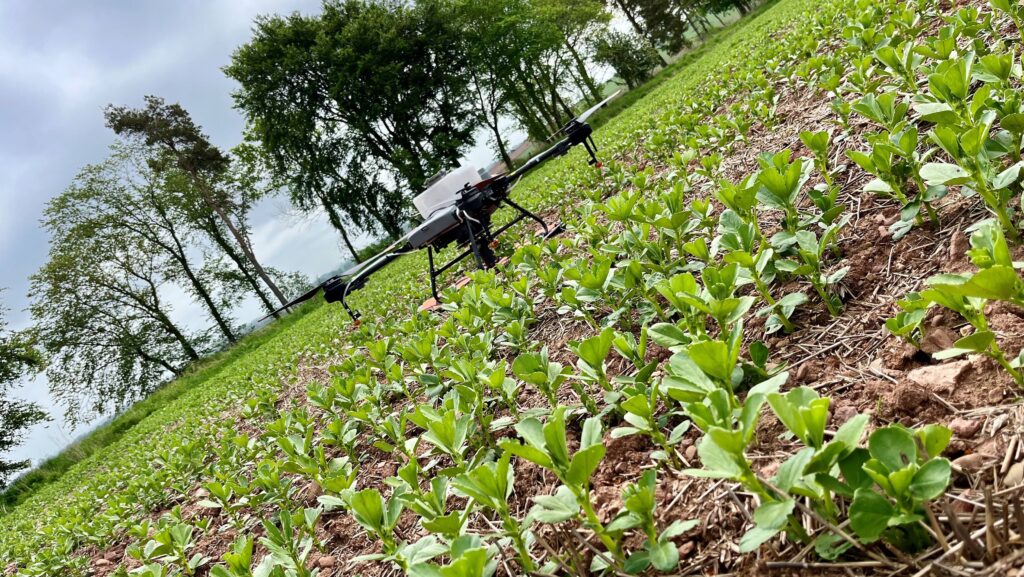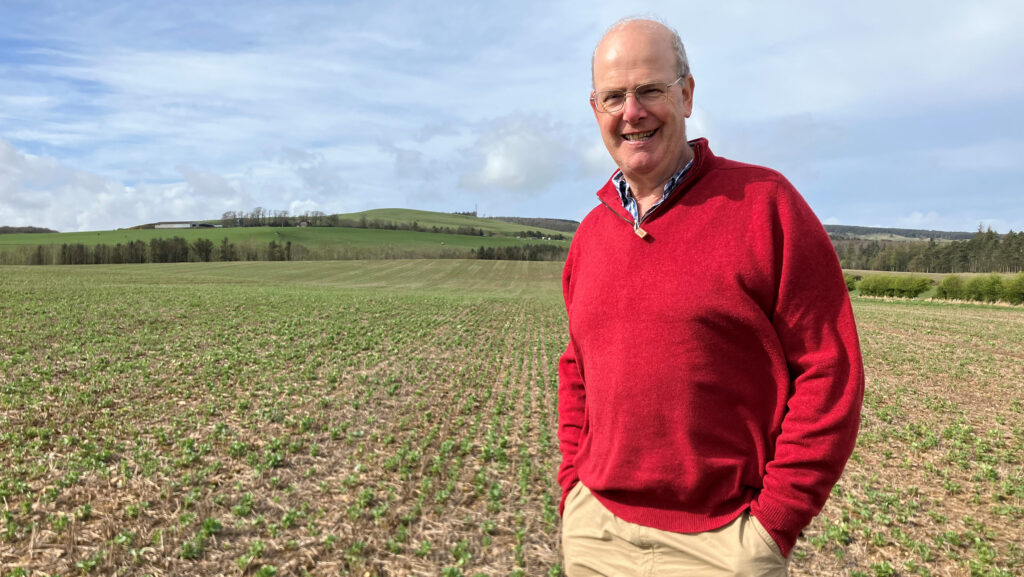Why pollinators are key to Scottish grower’s 6t/ha bean yield
 © Agrii
© Agrii Pollinating insects can increase bean yields by up to 50%. Emma Gillbard visits a farmer who is using beetle banks and grass margins to boost yield and cut chemical use.
Scottish farmer John Seed is using the power of pollinators to grow 6t/ha spring bean crops with zero insecticides, purchased P and K or pre-harvest glyphosate.
Pollinating insects are vital to successful field bean production, which is why John has established a range of flowering grass margins and beetle banks to encourage beneficial insect populations on the farm.
See also: How an Essex oat grower hit variable cost of £48.50/t
According to the Processors and Growers Research Organisation (PGRO) pollinators can promote field bean yield by 17 to 30%.
This can rise to over 50% when crops are affected by heat stress.
“There is more to be done to improve yield by looking after pollinators than there is by applying fertiliser and other chemicals. The less chemical inputs, the better,” says John.
Biodiversity boosts yield
In a drive to increase biodiversity and encourage pollination at Woodend Farm in the Scottish borders, John and his wife Louise established 5m multi-species grass and flower-rich margins around every field perimeter and seven beetle banks across the 180ha farm.
Breaking up large fields up to 40ha in size created a habitat haven and highway for insects to easily move around the farm.
The biodiversity boost not only increased pollinators, and consequently bean yield, but also eliminated the need for insecticides across the farm, as natural predator populations thrived.
“Bean crops grown next to the beetle banks are noticeably thicker with more than 15% higher yields. There really is a clear difference.
“However, this yield benefit is not so apparent in other crops which highlights the fact beans are so reliant on pollination as a yield factor,” says John.
This is because pollinating insects – particularly bees – set seed in field beans via cross-pollination and help facilitate self-pollination.
The proportion of seed produced by each mode of pollination varies with variety, level of cross-pollination and with crop stress and disease.
Yields of bee-pollinated bean crops can also be 20% less variable, with greater harvest index, shorter straw, and earlier ripening.
Shorter straw length means crop canopies are less likely to lodge, while faster ripening means an earlier harvest and reduced reliance on pre-harvest glyphosate sprays – something which is particularly important for John.

John Seed © Emma Gillbard
Cutting chemical use
John now grows a total of 40ha of winter and spring beans, destined as animal feed for his flock of 32,000 laying hens, in a bid to increase home grown protein.
Growing crops with as little chemical input as possible is a key objective of his, in order to promote soil health and keep costs to a minimum.
Last year, spring beans averaged 5.5 to 6t/ha, with just the one pre-emergence herbicide and a single chocolate spot spray.
John previously used pre-harvest glyphosate to desiccate the crop and destroy weeds lurking beneath the bean canopy, but he now lets crops naturally senesce with the help of disease and pollinators.
“We apply one chocolate spot spray early in the season to protect the crop and maximise green leaf area, but that’s it.
“An influx of disease later in the season is not necessarily a bad thing as this can help the crop naturally die off,” says John.
Together with the benefit of pollinators bringing crops to maturity earlier, John has now successfully stopped using glyphosate for the last two years.
This has also been made possible by having an on-floor biomass-fired grain drying system that will dry beans from over 20% moisture to 13% in less than a week.
P and K fertiliser
John’s ambition to cut chemical use at Woodend Farm does not stop there. The inclusion of chicken litter in the arable rotation has hugely improved soil fertility and organic matter levels.
There have been no applications of purchased P and K fertiliser or lime for the past seven years.
NCS project: Undersowing spring beans with clover and vetch
John Seed is taking part in the Nitrogen Efficient Plants for Climate Smart Arable Cropping Systems (NCS) project, which aims to increase pulse and legume cropping in UK arable rotations from 5% to 20%.
As part of the project, he is trialling the establishment of a vetch and white clover understory beneath a crop of spring beans.
The ambition is to fix as much nitrogen as possible in the field to reduce N use in the following crop of winter wheat.
The understory will also act as a weed suppressant, smothering out any potential weeds beneath the bean canopy.
The crop of Vixen spring beans were sown mid-March at a seed rate of 350kg/ha in a tramline trial.
With the help of drone company Skippy Scout, a drone was used to broadcast the legume mix into the standing crop in mid-May.
“I got involved with the project as it is offers a chance for practical on farm trials. Too often farmers are told what to do and what not to do by policymakers.
“What works in theory in the lab does not necessarily work on farm so this is a real opportunity to be a part of valuable industry research,” says John.
The NCS project is a farmer-led research programme, involving 17 industry and research partners and more than 200 farmers.
Pollenize pollinator monitoring project
Pollinator populations are being monitored and recorded at John Seed’s farm in the Scottish Borders as part of a new project run by conservation group Pollenize.
The conservation group is based in Plymouth, Devon, and aims to combat pollinator decline through the power of data collection, environmental DNA techniques and community beekeeping.
Sensors and camera monitors set up at John’s farm are collecting information on an array of bee and moth species.
“We’re trying to identify which species are present on farm, which are not and what we can do to enhance certain populations,” he says.
“I’m also taking pollen samples and sending this off to a university for DNA sampling in order to make further assessments on bee behaviour and floral analysis,” he says.
Testing pollen with DNA techniques will help researchers better understand forage availability at specific locations, which can be used to identify gaps in certain floral species on farm.
Seed mixes can then be planted to promote specific pollinators and create the required habitats.
“It’s great to be involved with the project helping to promote biodiversity which also brings an economic return by providing pollinator services for our bean crops and apple orchard,” says John.

